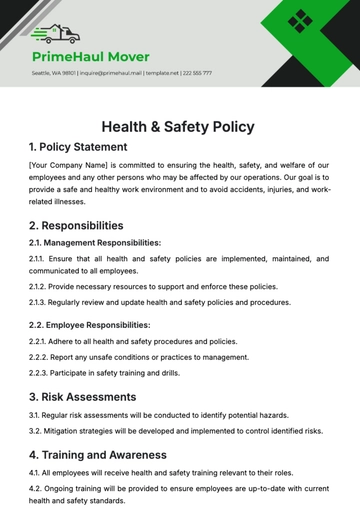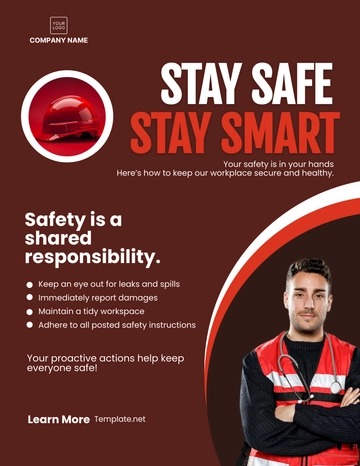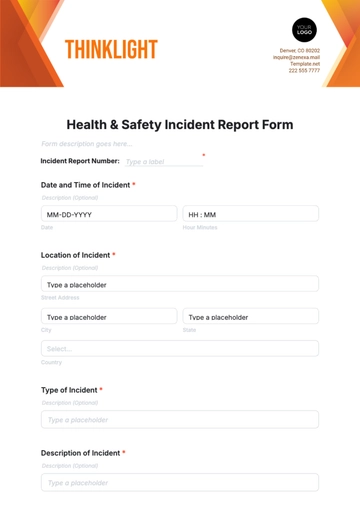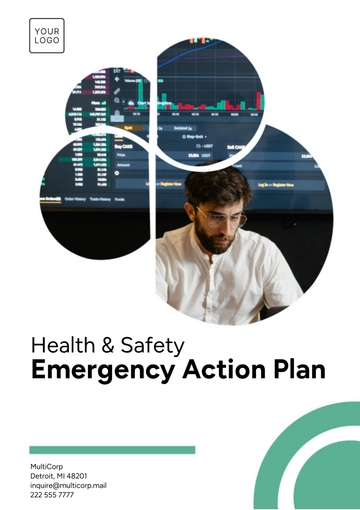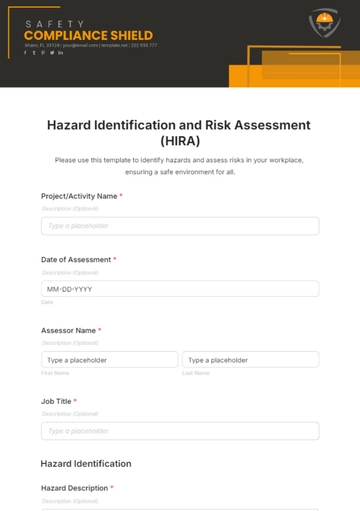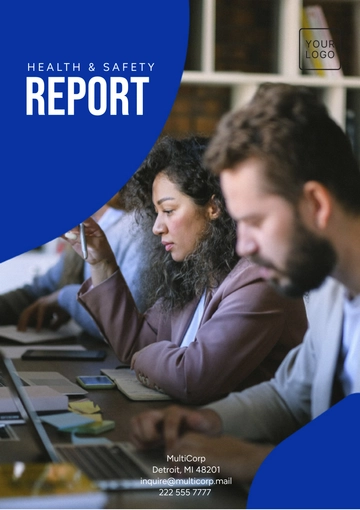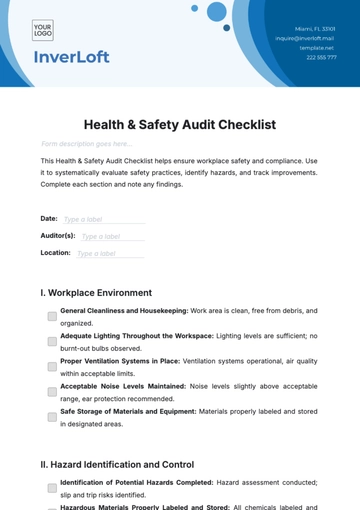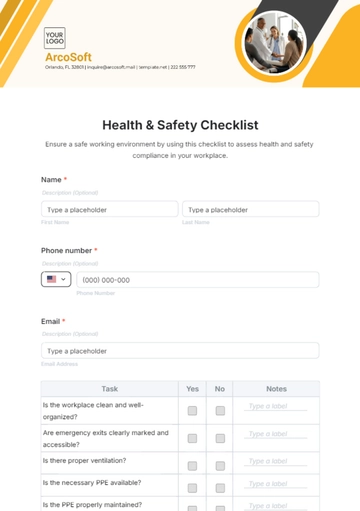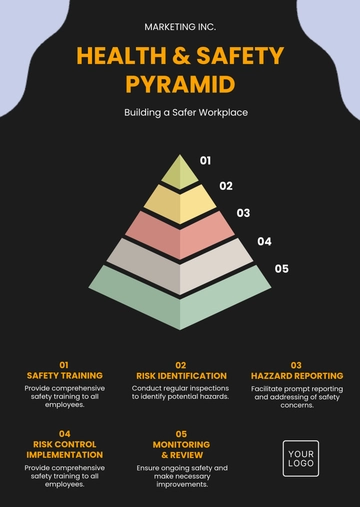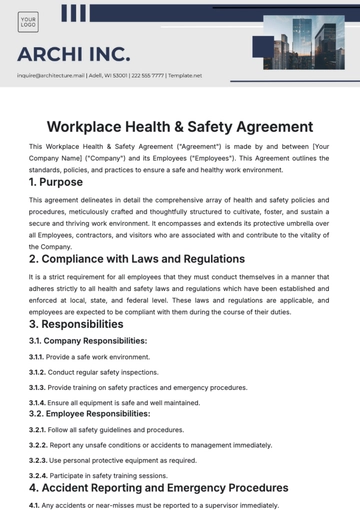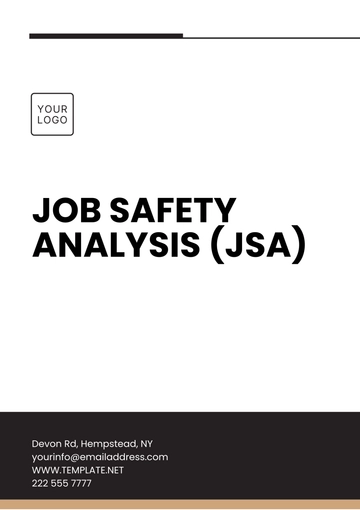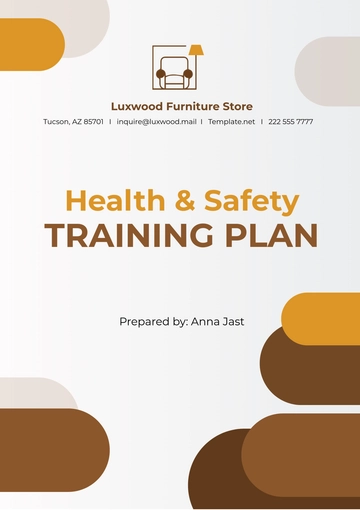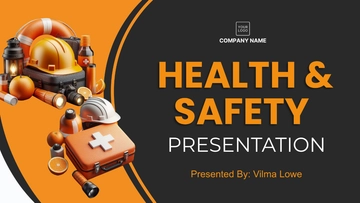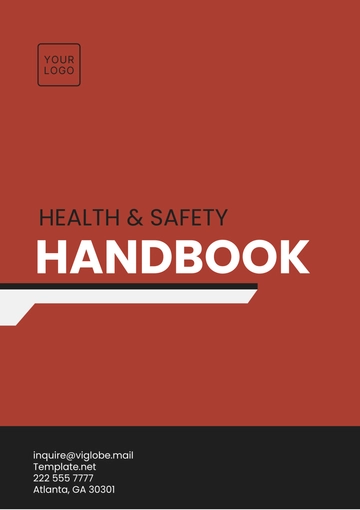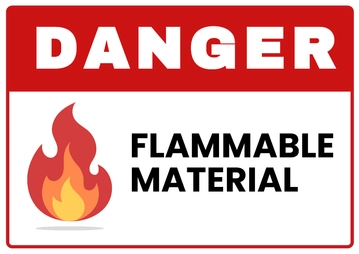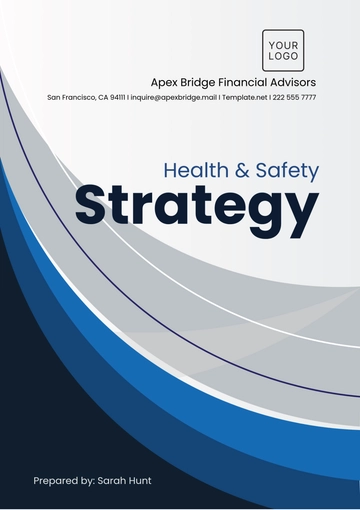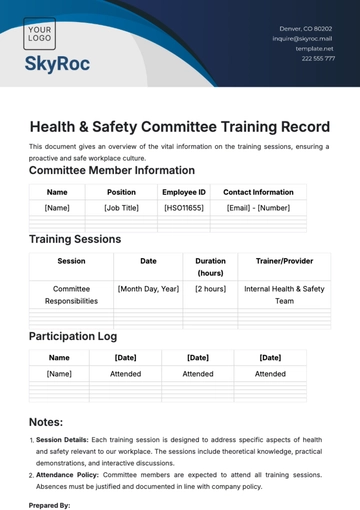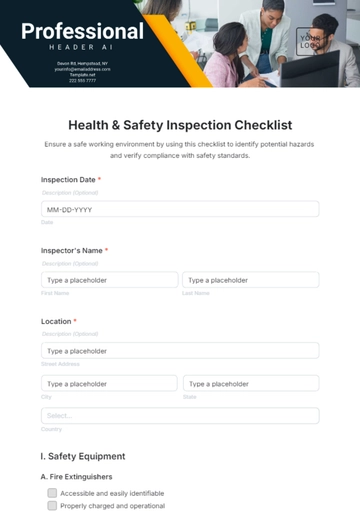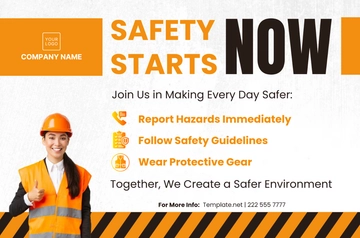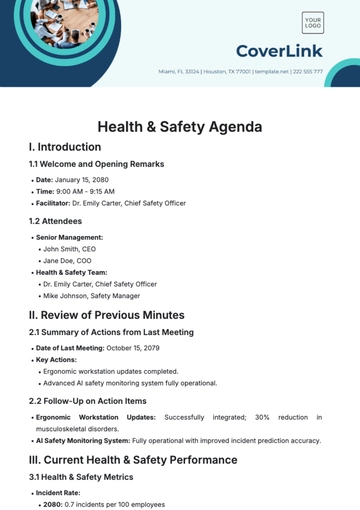Free Health & Safety Communication Guide
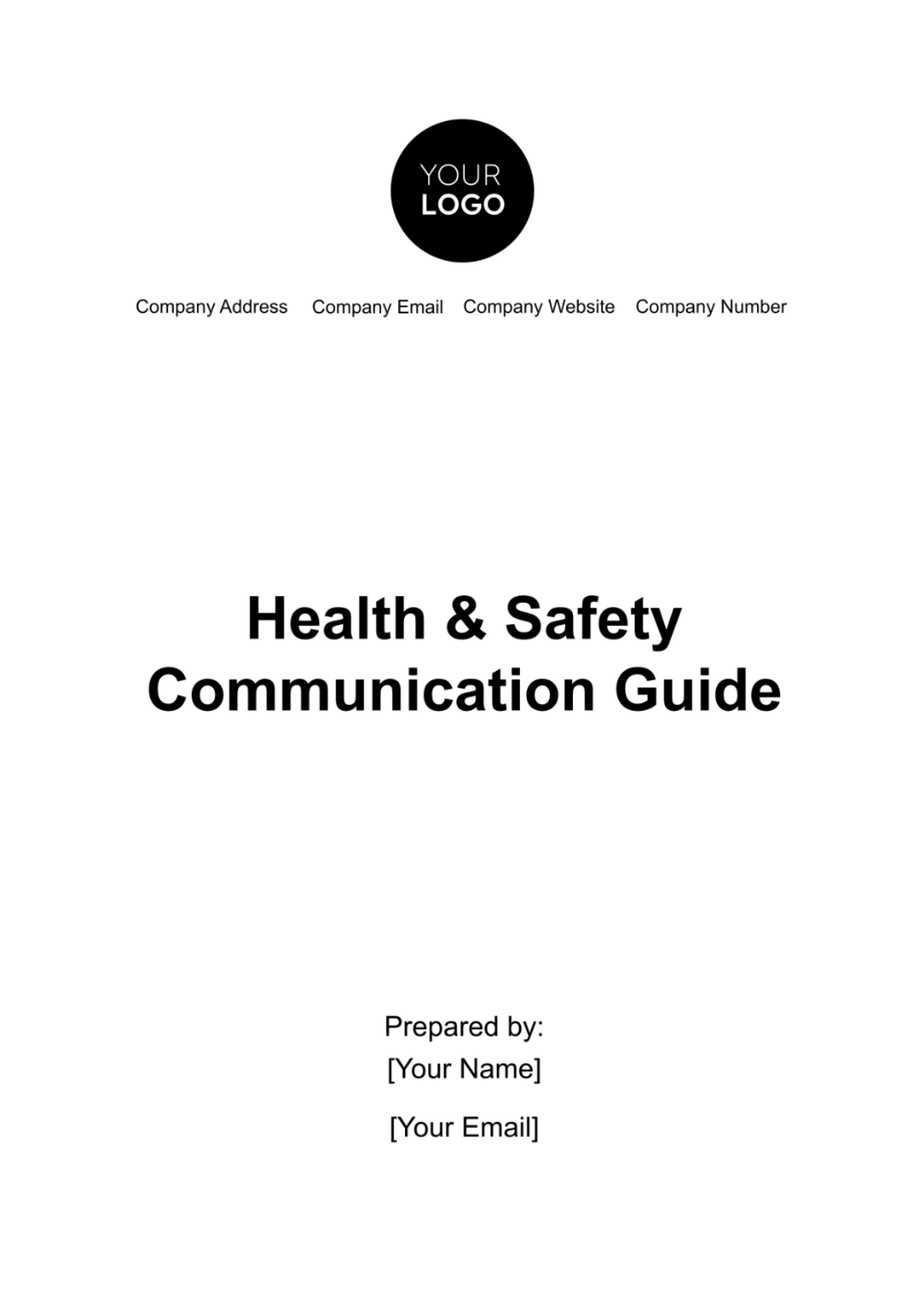
Introduction
A. Overview of Health and Safety Communication
In the dynamic environment of [Your Company Name], effective communication is foundational to maintaining a safe and healthy workplace. This section provides a holistic view of the various communication strategies and channels employed to address health and safety concerns within the organization.
We recognize that an informed and engaged workforce is essential for preventing accidents, mitigating risks, and fostering a culture of safety. Through this guide, we aim to transparently communicate our commitment to health and safety, ensuring that every member of the [Your Company Name] community is aware of their role in maintaining a secure working environment.
B. Purpose of the Guide
The primary purpose of this guide is to serve as a comprehensive reference document for all employees, contractors, and stakeholders associated with [Your Company Name]. It outlines the organization's approach to health and safety communication and provides clear guidance on protocols, procedures, and resources.
By clearly defining the purpose of this guide, we underscore our dedication to transparency, accountability, and the well-being of everyone within the [Your Company Name] community. This guide is a living document that will evolve in tandem with our commitment to continuous improvement in health and safety practices.
C. Regulatory Compliance
[Your Company Name] operates within a framework of stringent health and safety regulations. This section provides an overview of the regulatory standards that govern our practices, ensuring compliance at both federal and local levels. By adhering to these regulations, we affirm our commitment to creating a workplace that not only meets but exceeds safety standards.
Key Contacts
A. [Your Company Name] Health and Safety Team
The [Your Company Name] Health and Safety Team comprises dedicated professionals responsible for developing, implementing, and overseeing health and safety policies. Key contacts within this team include:
1. [John Brown], Health and Safety Manager
As the Health and Safety Manager, John Brown brings [7 years] of experience in promoting and maintaining a safe working environment. He leads our efforts in ensuring compliance with health and safety regulations and is a valuable resource for any related inquiries.
2. Contact Information
Email: [john.brown@yourcompany.com]
Phone: [(555) 185-4625]
B. Emergency Contacts
In emergency situations, quick access to essential contacts is critical. Please take note of the following emergency contact details:
Medical Emergency Services: 911
For immediate medical assistance, dial 911. Emergency medical services are available 24/7 to address any health-related concerns.
Local Emergency Services: [Local Emergency Number]
Insert the local emergency number specific to your location, ensuring that all members of the [Your Company Name] community are aware of the appropriate contact in times of crisis.
Health and Safety Policies
A. [Your Company Name] Safety Policies
At [Your Company Name], safety is our top priority. This section outlines key safety policies that everyone within the organization is expected to adhere to.
Safety Policy Statement
[Your Company Name] is committed to providing a safe and healthy working environment for all employees, contractors, and visitors. Our safety policy statement emphasizes the importance of proactive safety measures, continuous improvement, and the shared responsibility of everyone within the organization.
Incident Reporting Procedures
In the event of an incident, timely reporting is crucial for swift resolution and prevention of future occurrences. This subsection details the step-by-step procedures for reporting incidents, including the necessary documentation and communication channels.
B. Legal Compliance
To ensure comprehensive health and safety practices, [Your Company Name] complies with both federal and local regulations.
Federal Regulations
This subsection provides an overview of the federal regulations that [Your Company Name] follows, ensuring that our health and safety practices align with national standards.
State/Local Regulations
Recognizing the diversity of regulatory requirements, [Your Company Name] adheres to state and local health and safety regulations. This section highlights the specific regulations relevant to our locations.
Communication Channels
A. Internal Communication
Effective internal communication is essential for disseminating crucial health and safety information. This section details the internal communication channels used within [Your Company Name].
Company Intranet
Our company intranet serves as a centralized platform for sharing important health and safety updates, policies, and resources. Employees are encouraged to regularly check the intranet for the latest information.
Health and Safety Meetings
Regular health and safety meetings are conducted to facilitate direct communication between management and employees. These meetings provide a forum for discussing safety concerns, sharing best practices, and fostering a collaborative approach to workplace safety.
B. External Communication
Beyond the internal audience, [Your Company Name] communicates its commitment to health and safety externally to stakeholders and the public.
[Your Company Website]
The company website serves as a public-facing platform for sharing general health and safety information, updates, and relevant resources. Visitors to the website can access information about our safety practices and initiatives.
[Your Company Social Media]
Social media platforms are utilized to share timely health and safety updates, promote safety awareness campaigns, and engage with the broader community. [Your Company Social Media] serves as an additional channel for connecting with stakeholders and fostering a culture of safety.
Training Programs
A. Employee Training
Onboarding
New employees at [Your Company Name] undergo a comprehensive onboarding program that includes detailed health and safety training. During onboarding, employees receive information about safety policies, emergency procedures, and the proper use of safety equipment. This initial training ensures that all employees start their journey with a solid understanding of the importance of health and safety in the workplace.
Periodic Training
To maintain a high level of awareness and preparedness, [Your Company Name] conducts periodic health and safety training sessions for all employees. These sessions cover a range of topics, including updated safety protocols, new equipment usage guidelines, and any relevant changes to health and safety regulations. Periodic training sessions are designed to reinforce safety practices and address emerging concerns.
B. [Your Partner Company Name] Collaboration
Joint Training Programs
As part of our commitment to safety collaboration, [Your Company Name] collaborates with [Your Partner Company Name] to develop and conduct joint training programs. These programs aim to create a standardized approach to health and safety that benefits both organizations. By sharing best practices and resources, employees from both companies gain a broader understanding of safety protocols and contribute to a safer working environment.
Shared Resources
[Your Company Name] and [Your Partner Company Name] share resources, including training materials, safety manuals, and online modules. This collaboration ensures consistency in training content and provides employees with access to a wealth of knowledge. Shared resources contribute to the effectiveness of training programs, fostering a culture of safety that extends beyond individual organizations.
Incident Reporting
A. Reporting Procedures
Timely and accurate incident reporting is fundamental to our commitment to continuous improvement in health and safety. This section outlines the procedures employees must follow when reporting incidents. Whether it's a near miss, injury, or potential hazard, employees are encouraged to report promptly using designated reporting channels. Clear reporting procedures help identify trends, address immediate concerns, and implement preventive measures.
B. Investigation Process
Root Cause Analysis
In the event of an incident, [Your Company Name] conducts a thorough root cause analysis. This process involves investigating the factors that led to the incident, identifying underlying causes, and implementing corrective actions. The goal is not only to address the immediate issue but also to prevent similar incidents in the future. Root cause analysis contributes to a culture of learning from experiences and continuously improving safety protocols
Corrective Actions
Based on the findings of the investigation, corrective actions are implemented to address identified issues. This may involve updates to safety procedures, additional training, or improvements to equipment and facilities. The corrective actions are communicated to the workforce, ensuring transparency and reinforcing the organization's commitment to a safe working environment.
Safety Equipment and Protocols
A. Personal Protective Equipment (PPE)
[Your Company Name] mandates the use of Personal Protective Equipment (PPE) in applicable work areas. Employees are provided with the necessary PPE, including but not limited to:
Safety helmets
Safety glasses
Gloves
Hearing protection
Respirators
Employees are required to wear PPE as specified in their job roles and adhere to usage guidelines provided during training sessions.
B. Equipment Usage Guidelines
[Your Company Website] Resources
Detailed guidelines on the proper usage of equipment and specific safety protocols can be found on [Your Company Website]. Employees are encouraged to reference these resources for up-to-date information on equipment handling and safety measures.
User Manuals
User manuals for all equipment used at [Your Company Name] are readily available for employees. These manuals provide comprehensive instructions on equipment operation, maintenance, and safety precautions. It is essential for employees to familiarize themselves with the relevant user manuals to ensure safe and efficient equipment usage.
Health and Wellness Initiatives
A. Employee Assistance Programs (EAP)
[Your Company Name] is committed to the overall well-being of its employees. The Employee Assistance Program (EAP) provides confidential counseling and support services to help employees manage personal and work-related challenges. Accessible resources and counseling sessions are available to all employees seeking assistance.
B. Wellness Activities
1. Fitness Programs
To promote a healthy lifestyle, [Your Company Name] offers fitness programs for employees. These programs include gym memberships, fitness classes, and wellness challenges, encouraging employees to prioritize physical well-being.
2. Mental Health Support
Recognizing the importance of mental health, [Your Company Name] provides resources and support for employees facing mental health challenges. This includes access to counseling services, stress management workshops, and initiatives to reduce stigma surrounding mental health issues.
Performance Metrics
A. Safety Performance Indicators
1. Incident Rates
[Your Company Name] tracks incident rates as a key safety performance indicator. This includes recording and analyzing workplace incidents, injuries, and near misses. The data collected is used to identify trends, implement preventive measures, and continuously improve safety protocols.
2. Near Miss Reports
Employees are encouraged to report near misses to identify potential hazards and prevent future incidents. Near miss reports play a crucial role in enhancing safety awareness and fostering a proactive safety culture within the organization.
B. Continuous Improvement
1. Lessons Learned
[Your Company Name] actively promotes a culture of learning from incidents. Lessons learned from incident investigations, safety audits, and employee feedback contribute to the ongoing improvement of health and safety practices. This iterative process ensures that the organization remains responsive to evolving safety challenges.
2. Feedback Mechanisms
To engage employees in the improvement process, [Your Company Name] establishes feedback mechanisms. These may include surveys, suggestion boxes, and regular forums for employees to share insights and suggestions related to health and safety. Feedback is valued and considered in the continuous enhancement of safety procedures.
- 100% Customizable, free editor
- Access 1 Million+ Templates, photo’s & graphics
- Download or share as a template
- Click and replace photos, graphics, text, backgrounds
- Resize, crop, AI write & more
- Access advanced editor
Introducing Template.net's Health & Safety Communication Guide Template. This editable and customizable guide provides a comprehensive framework for effective communication strategies in promoting workplace health and safety. With our Ai Editor Tool, tailor the guide to your organization's specific needs, ensuring clear and concise communication to enhance safety protocols.

